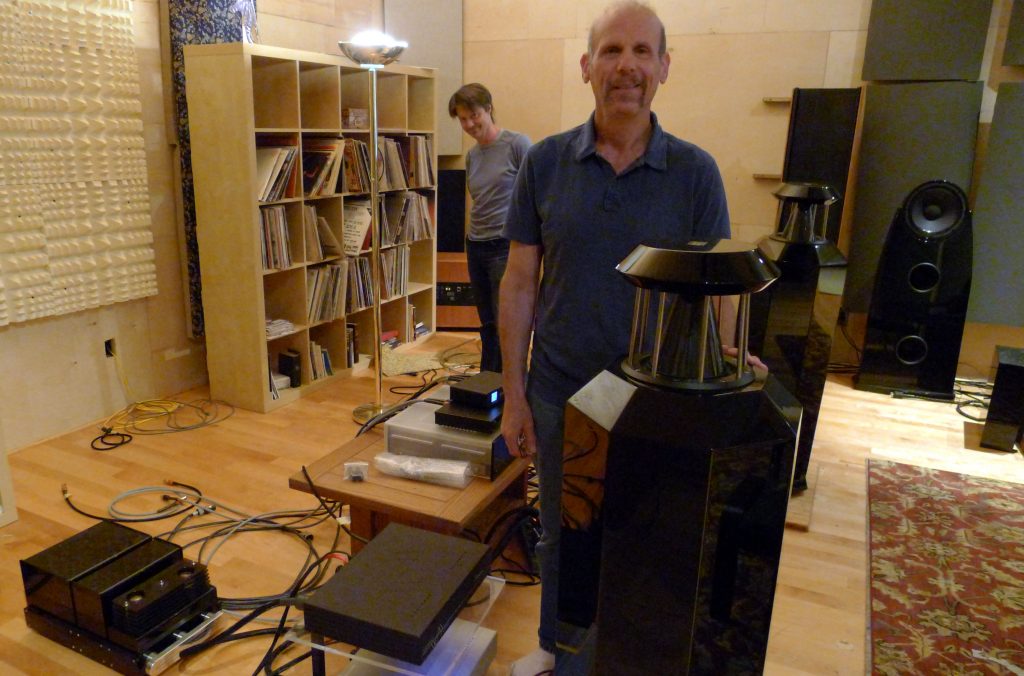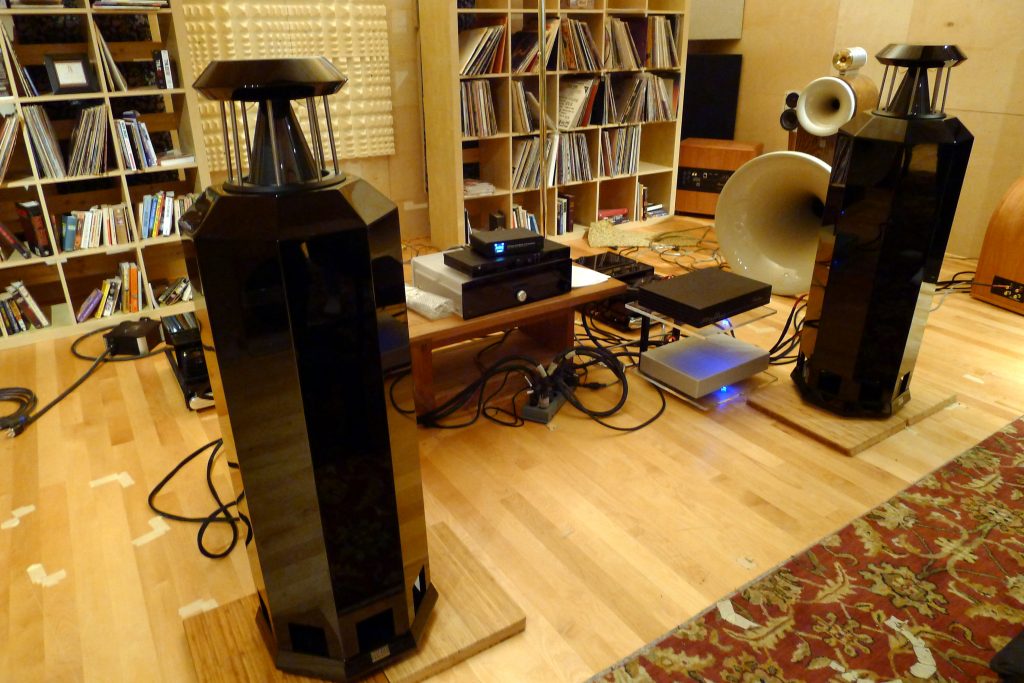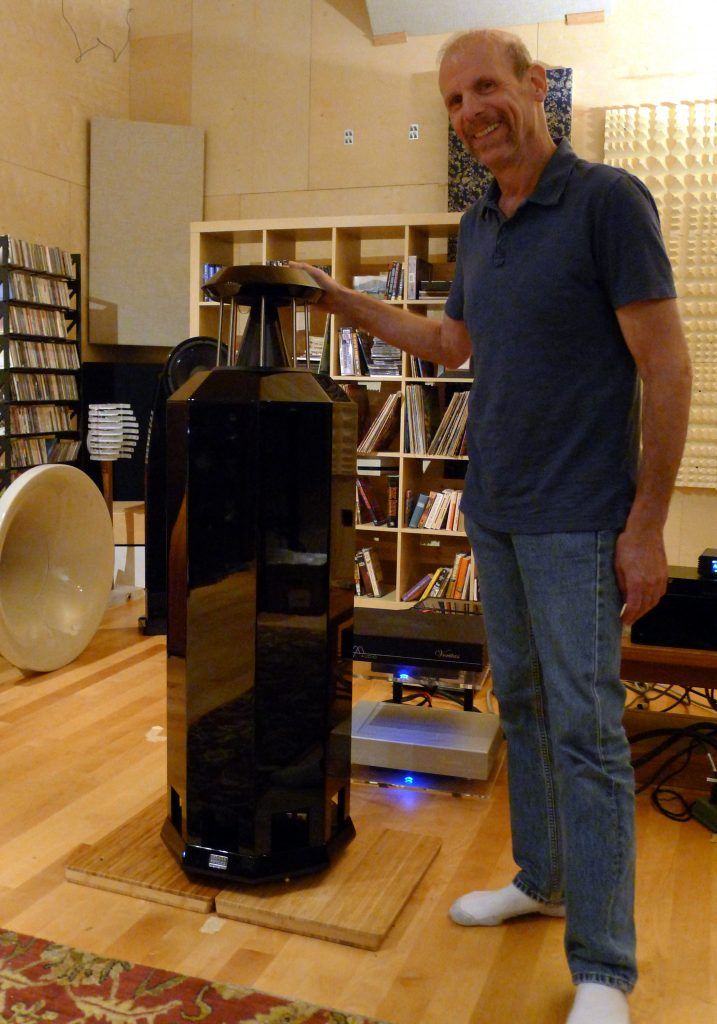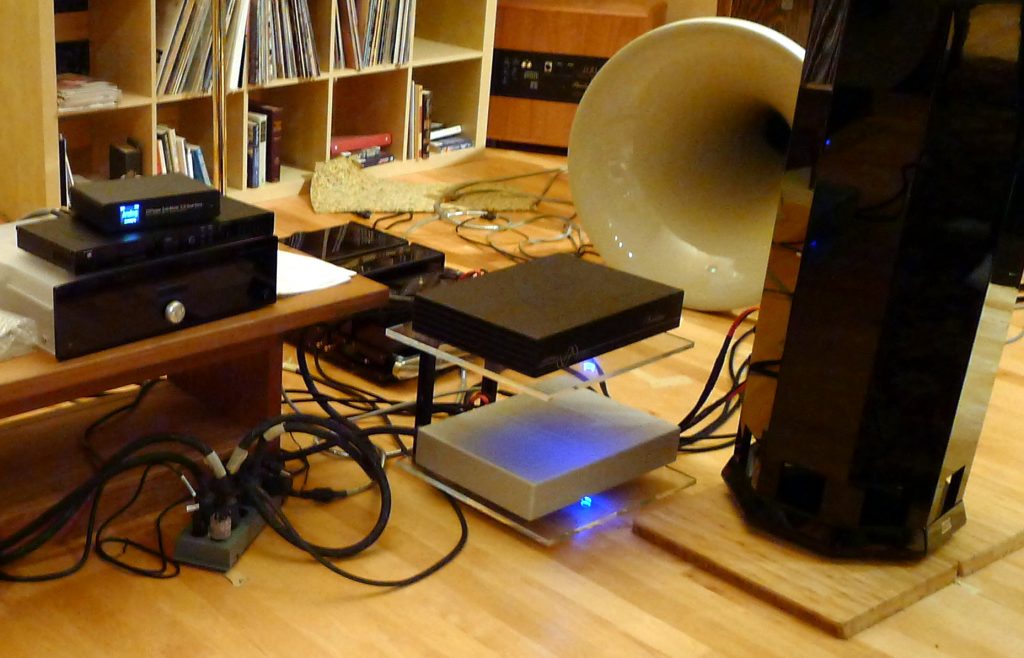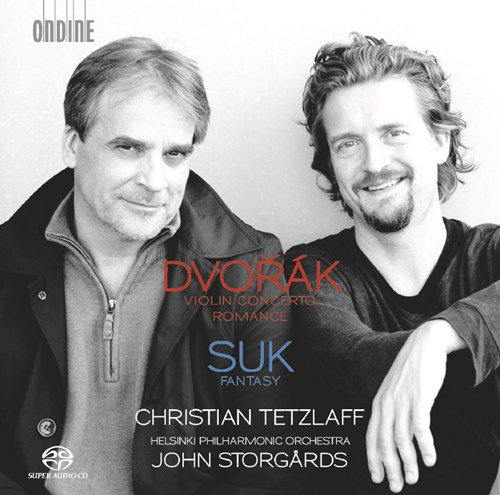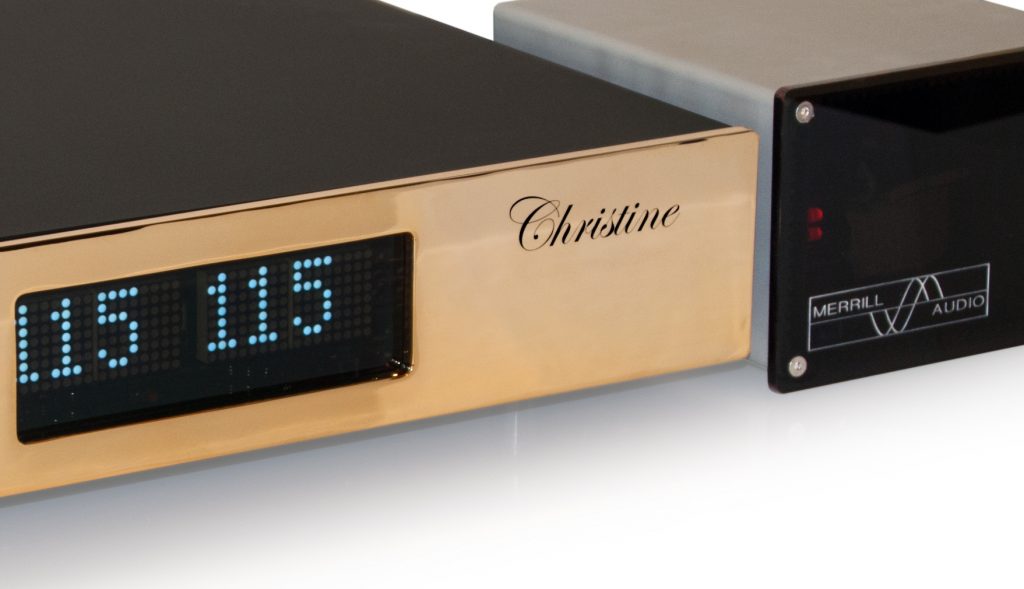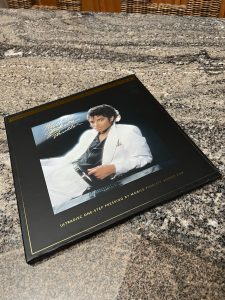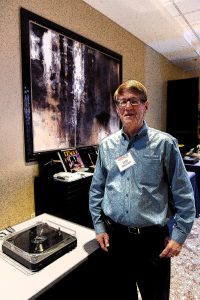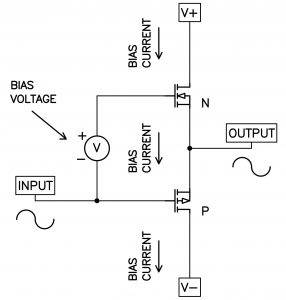The coincidences were uncanny. Exactly a year ago to the date we first visited Distinctive Stereo. Plus two weekends before that we had gone to Mezzrow, a small jazz club in the West Village, to hear clarinetist Ken Peplowski. Guess where we were and who we saw two weekends before this year?
The outing was unfolding with an eerie familiarity. I wondered if the portents would hold true for my sonic impressions, as well.
On a beautiful late summer afternoon Lynn and I met up with my buddy Dave, a regular on my panel, at the New York Waterway ferry terminal at West 39th Street. After an eight minute ride, we docked at Port Imperial/Weehawken, and were met by Larry Borden, the proprietor of Distinctive Stereo, an appointment-only home dealership in northern New Jersey.
Larry (and Dave in the background)
The Soundroom
Upon arrival at his emporium an hour later, we settled into the main listening area, a dedicated soundroom measuring 30' L x 22' W x 11' H. It is set-up for near-field listening: the loudspeakers and the sweet spot chair form roughly an equilateral triangle. Apart from the acoustic treatments on the walls the gear appeared to be little changed; the biggest difference was the German Physiks Borderland loudspeakers on the floor, the next model up from the HRS-130 (MSRP $22,750) we heard last year.
The German Physiks Borderland loudspeakers
My premonition about the sonics held true. The attractive, well-balanced presentation was very much what we heard last year. All German Physics models use the same wide-bandwidth, omnipole DDD driver for the mids and treble. In addition, the HRS-130 and the Borderland models are two driver designs employing a downward firing woofer, a 10" for the HRS-130 handling the frequencies between 29-220Hz, and a 12" handling 28-190Hz for the Borderland. Thus the sonic similarity.
But while the HRS-130 was never able to fully pressurize the rather large listening room, the Borderland did it effortlessly. The Borderland is physically bigger and heavier than the HRS-130 (119 vs. 75.9 lbs.) and is designed for rooms anywhere between 160 to 950 square feet. Most rooms fall into that range.
As Larry explained his priorities to me last year, "Dynamics is at the top of my list, followed by speed. If a piece of gear doesn't have dynamics, there's no life. I'm not interested in it." He's not kidding.
Biamping with Merrill Audio Veritas Monoblocks
The Borderland is relatively power hungry, with a sensitivity of approximately 86.1 dB and a nominal impedance of 3.7 Ohms. But that did not present a problem. Last year he demoed the HRS-130 with two pairs of Merrill Audio Veritas Monoblocks. The same amplifier configuration was in place for the Borderlands. That meant each channel was being serviced with 800 watts.
The System
The complete system we listened to was comprised of:
- German Physiks Borderland Mk. IV. MSRP $33,500
- Merrill Audio Christine Linestage. MSRP $12,000
- Merrill Audio Veritas Monoblocks. MSRP $12,000
- SONY Blue Ray Player, as a transport only
- EMM Labs DAC2x. MSRP $15,500
- Aurender N10 Music Server
- Merrill Audio ANAP speaker and interconnect wires.
- Various power cords, including Waveform Fidelity HE on the Veritas amps
The Sound
I was particularly keen to play the Dvořák Violin Concerto with Christian Tetzlaff (Ondine CDE 1279-5 SACD), a splendid recording that wowed us last year. I remember the HRS-130 loudspeakers threw a huge soundstage placed well behind the loudspeakers, close to the front wall and nearly touching the side walls. It was much wider and deeper than I get at home and populated across the expanse with a large group of players, nearly approaching what you would hear in a rear orchestra seat. The Borderlands recreated it.
Just like last time, it was striking in its seamlessness and gave the impression you are looking at an actual stage. Instruments don't pop out at you and nothing can be localized in the drivers—the loudspeakers disappear—yet it is quite vivid. The images are round and have lots of space around them. I was reminded of the old adage: the room is your biggest component. Larry pays a lot of attention to room acoustics and it shows.
The coherency of the German Physiks loudspeakers is outstanding. It is a two-way design and the drivers couldn't be more dissimilar: an omnipole handling the mids on up; a dynamic woofer below. You would think coherency is not easily achieved, especially with a crossover point at 190Hz. That means the woofer is run right into the midrange, where the human ear is very sensitive. Usually woofers crossover at around 80Hz.
The downward-firing woofer has a 360 degree radiation pattern matching that of the DDD. Plus the DDD and woofer both use a 12dB/octave electronic and 18dB/octave acoustic cross-over. These design choices greatly assist coherency. And the quality of the low frequencies was very good, which left me puzzled as well. How can a downward firing woofer manage tight and textured bass These qualities are usually the province of forward firing designs.
The Merrill Christine Preamplifier
The sound didn't leave much to complain about. I mentioned to Larry that the only thing I would want is a little boost in the lower-mids—that would be the icing on the cake. Then he astonished me by how easily he could accommodate my request.
A suite of Merrill Audio electronics rounded out the system. The Merrill Christine Preamp has two outputs and each has an independent volume control. Since he was biamping the speaker, he was therefore able to boost the volume of the output to the woofer with a couple of commands on the preamp's remote control. Nice! This preamp feature allows speedy adjustment of the tonal balance and, as I advised Larry, gives him the ability to accommodate individual listeners' taste.
The German Physiks Borderland Mk. IV loudspeakers
At my request, Larry provided the following technical statement:
The Borderland Mk. IV, like all German Physics loudspeakers, is based on the DDD, a wide-bandwidth, omnipole driver. (The exact same DDD is used in all German Physics models.) The downward firing woofer has a 360 degree radiation pattern, which exactly matches that of the DDD.
The Borderland MK IV uses an octagonal cross-section cabinet constructed from heavy panels of MDF, with re-enforcements fitted to critical points within the structure. The use of an octagonal cross-section allows the individual panels to be made smaller and therefore stiffer than they would be if a conventional square or rectangular cross-section were used. Residual resonances are minimized by applying a special damping material called Hawaphon® to the inside of each panel. Hawaphon® is a polymer sheet containing a matrix of small cells filled with very fine steel shot and was originally developed as an anti-surveillance measure for use in military and government buildings. It adds mass to the panel to reduce the resonant frequency and the ability of the shot in each cell to move against each other provides a very effective way of converting vibration energy into heat. To damp resonances of the air within the cabinet, the whole of the inside of the cabinet is lined with a thick layer of high-density felt.
Another advantage of the Borderland MK IV design is that the DDD driver passes comparatively little potentially resonance-creating energy into the cabinet. This is because its low moving mass means that the reaction forces it generates are also low and because the DDD driver sits on top of the cabinet, these forces are at right angles to the direction that that cabinet panels would naturally flex. Consequently, less energy enters the cabinet than would be the case if the driver was attached perpendicular to a panel and thus the reaction forces it created were in the same direction that panel would naturally flex.
All woofers—and in fact, all drivers—have a resonant frequency. The top of the Borderland Mk. IV cabinet contains a Helmholtz resonator which is tuned to the resonant frequency of the woofer, thereby cancelling out the woofer resonance.
Nearing the end, we briefly listened to a couple of tracks via the Aurender N10 music server. Larry said he will support vinyl in the near term: a VPI table and the Merrill Jens phono stage were mentioned. That will be rather tasty.
Going Home
The Borderland is the second German Physiks speaker I've checked out at their North American distributor, Distinctive Stereo. There was more than a passing resemblance with the HRS-130 model I heard last time. These loudspeakers do just about everything right, given their price points, and leave very little to critique.
You should pay a visit to Distinctive Stereo. Larry Borden has achieved a sound that goes beyond what you'll hear at High End shows, even at most retail stores.
201.391.1411





